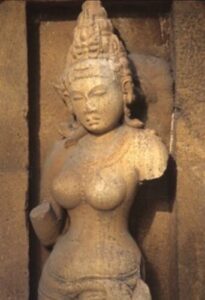Witness the grandeur of the lord at Chola temples tomorrow

Vijayalaya Cholisvara, Narthamalai, a 9th century temple located atop a hill at Narthamalai.
Team L&M
In about 850 AD, a Chola chieftain named Vijayalaya took control of Thanjavur and ushered in an era of unsurpassed prosperity and grandeur in Tamil Nadu. The most beautiful temples of South India were made under the rule of the Cholas.
At Narthamalai, located on top of a hill, amidst the great beauty of Nature, is a 9th century temple. An inscription names it as the Vijayalaya Cholishvara temple. It may have been made under Vijayalaya Chola or by the Muttarayas chieftains before his rule. The temple is dedicated to Shiva.
Dvarapalas or guardian figures are made at the entrance to the ardhamandapa or hall. They stand half-turned in the manner established in the Pallava period.

One hand displays the gesture of vismaya or wonder. Indeed it a sense of wonder which fills the art of this period. The temples are made with a jewel-like perfection. The temple itself and every sculpture on it serve to take us away from mundane concerns to a world filled with a sense of the wonder of all of creation.
A temple which marks the extraordinary quality of early Chola sculpture is the Brahmapurishvara at Pullamangai. The temples of the early Chola period were not very large. The purpose was not to inspire awe through size and grandeur. It was to take us to the world of gentleness which can be found within us. The grace of the figures and their profoundly peaceful expressions, awaken a sense of the sublime. The figures are fully occupied with the miracle of creation and the sense of stillness which comes from this absorption.
It is believed in Indic philosophy that the aesthetic experience is akin to Brahmananda, or the final bliss of salvation itself. It is in that moment, that the veils of illusion are lifted and we see the grace which is in all of creation. It is also believed that each moment of the experience of beauty leaves us just a little richer than before. Each time we are able to see the grace which is ever-present, we become more capable of perceiving it again. Till finally, we may lose ourselves completely in the divine which pervades all that there is.
Mooverkoil, the two remaining out of three Shiva temples at Kodambulur, strike the perfect balance between a dignified majesty of the spirit and the joy contained in it.
The temple is an embodiment of the divine in each of us. In the garbha griha or womb chamber, we are born again in knowledge of the formless eternal. Through niches in the walls of the temple, the deity is made visible in different forms to the devotee. Through these images, the divine is given a personality which the worshipper can relate to. The deity is made human, yet always filled with a luminosity which awakens the finest within us.

Ganas are some of the finest expressions of Chola art. In Indian art, the entire range of emotions and human life is given a place… be it glee, sorrow or mischief. Ganas are seen lost in devotion to the lord. We can relate most easily to them as they play their musical instruments or dance with elation. When beings are so enraptured can they be at all troubled by petty material concerns? The temple presents the path towards a bliss which knows no end.
In the year 1010, Rajaraja Chola completed the tallest and largest temple which had been made in India. The Brihadishvara, dedicated to ‘the Great Lord Shiva’ was made to express his own power and military might as much as the grandeur of the Lord. Rajaraja had greatly expanded his empire in all directions, including to the island of Sri Lanka. The temple was made to celebrate his achievements.
Rajaraja gave generous endowments of land and finances to run the large administration of the temple. We see here the beginnings of the temple as a great centre of the cultural activities of the community. Four hundred dancers were brought from 91 temples all over the empire, to dance in the temple complex.

By the 13th century, the power of the Cholas declined. Memories linger still of the four centuries of their rule. This was a flourishing time, of a great and sophisticated culture in Tamil Nadu. The finest temples were made. Sculpture was created which took the devotee to the deepest realms of the peace to be found within.
Under its Glimpses of Culture programme, India Habitat Centre is presenting a
film Grandeur of the Lord on July 23, at 6pm. The film was produced by
Art Historian, Film-maker & Photographer Benoy K Behl for Doordarshan.
To watch join here. Behl will also present an online talk.

